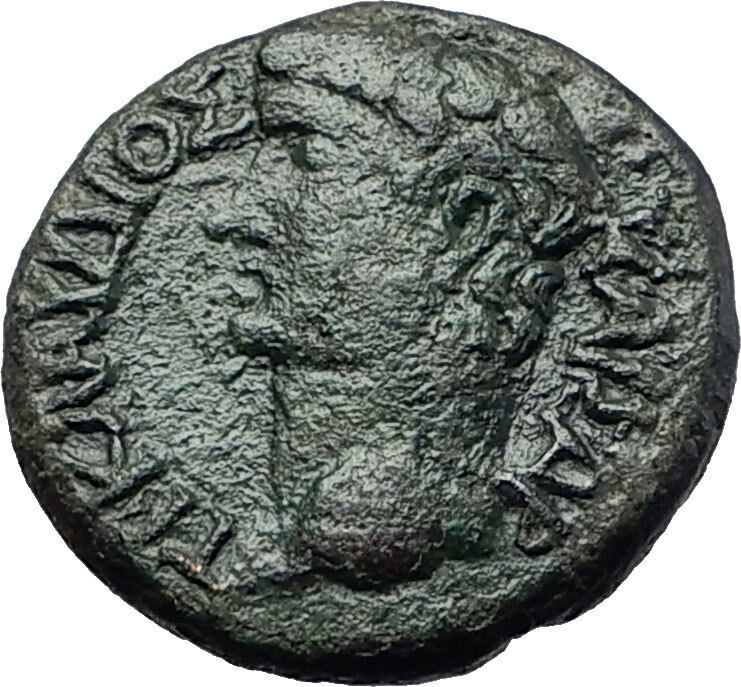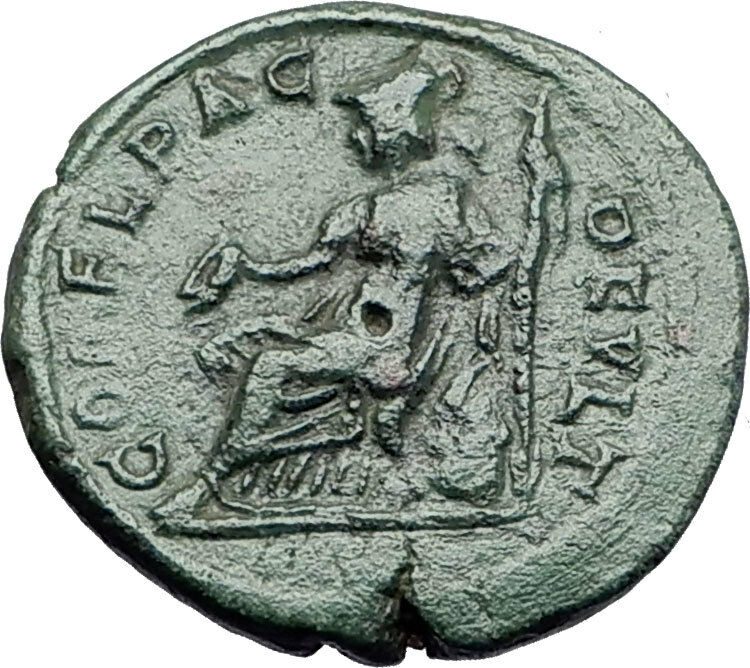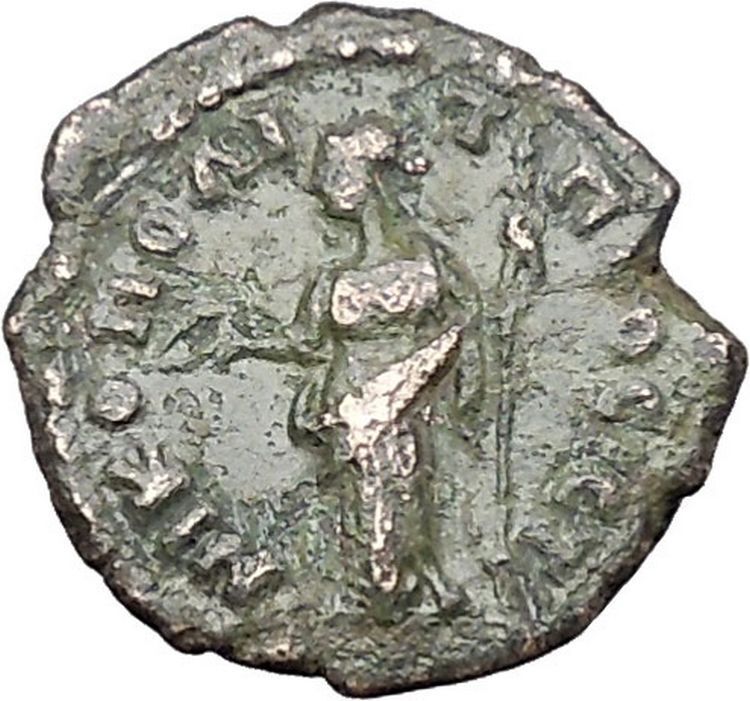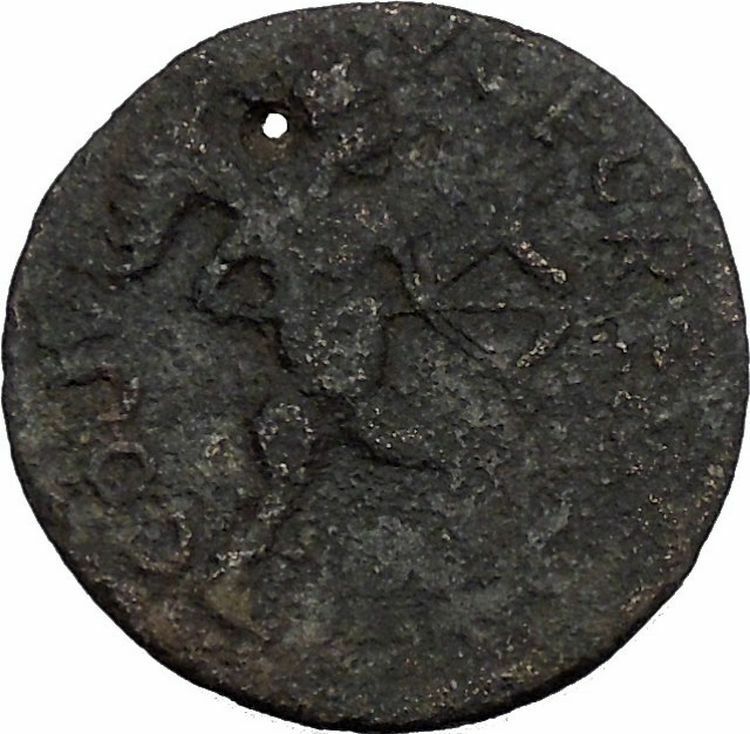|
Julia Mamaea
– Roman Empress wife of Emperor Severus
Alexander 222-235 A.D. –
Bronze 19mm (4.16 grams) of
Nicaea
in
Bithynia
circa 222-235 A.D.
IOVΛIA MAMAIA CEB, Diademed draped bust
right.
NIKAIEΩN between three legionary
standards
.
You are bidding on the exact
item pictured, provided with a Certificate of Authenticity and Lifetime
Guarantee of Authenticity.
The place is said to have been colonized by
Bottiaeans
, and to have originally borne the
name of Ancore (Steph.
B. s. v.) or Helicore (Geogr. Min. p. 40, ed. Hudson); but it
was subsequently destroyed by the
Mysians
. A few years after the death of
Alexander the Great
,
Macedonian
king
Antigonus
— who had taken control of much of
Asia Minor
upon the death of Alexander (under
whom Antigonus had served as a general) — probably after his victory over
Eumenes
, in 316 BC, rebuilt the town, and
called it, after himself, Antigoneia (Greek:
Αντιγόνεια). (Steph. B. l. c.; Eustath. ad
Horn. II. ii. 863) Several other of Alexander’s generals (known together as the
Diadochi
(Latin; original Greek
DiadokhoiΔιάδοχοι/
“successors”)) later conspired to remove Antigonus, and after defeating him the
area was given to
Thessalian
general
Lysimachus
(Lysimakhos) (circa 355
BC-281 BC) in 301 BC as his share of the lands. He renamed it Nicaea
(Greek:
Νίκαια
, also
transliterated
as Nikaia or Nicæa;
see also
List of traditional Greek place names
), in
tribute to his wife Nicaea, a daughter of
Antipater
. (Steph. B., Eustath., Strab., ll.
cc.) According to another account (Memnon, ap. Phot. Cod. 224. p. 233, ed.
Bekker), Nicaea was founded by men from
Nicaea
near
Thermopylae
, who had served in the army of
Alexander the Great. The town was built with great regularity, in the form of a
square, measuring 16 stadia in circumference; it had four gates, and all its
streets intersected one another at right angles, so that from a monument in the
centre all the four gates could be seen. (Strabo
xii. pp. 565 et seq.) This monument stood in the gymnasium, which was
destroyed by fire, but was restored with increased magnificence by the
younger Pliny
(Epist. x. 48), when he was
governor of Bithynia
.
The city was built on an important crossroads between
Galatia
and
Phrygia
, and thus saw steady trade. Soon after
the time of Lysimachus, Nicaea became a city of great importance, and the kings
of Bithynia, whose era begins in 288 BC with
Zipoetes
, often resided at Nicaea. It has
already been mentioned that in the time of Strabo it is called the metropolis of
Bithynia, an honour which is also assigned to it on some coins, though in later
times it was enjoyed by
Nicomedia
. The two cities, in fact, kept up a
long and vehement dispute about the precedence, and the 38th oration of
Dio Chrysostomus
was expressly composed to
settle the dispute. From this oration, it appears that Nicomedia alone had a
right to the title of metropolis, but both were the first cities of the country.
The younger Pliny makes frequent mention of Nicaea and its public buildings,
which he undertook to restore when governor of Bithynia. (Epist. x. 40, 48,
etc.) It was the birthplace of the astronomer
Hipparchus
(ca. 194 BC), the mathematician and
astronomer
Sporus
(ca. 240) and the historian
Dio Cassius
(ca. 165). It was the death-place
of the comedian
Philistion
. The numerous coins of Nicaea which
still exist attest the interest taken in the city by the emperors, as well as
its attachment to the rulers; many of them commemorate great festivals
celebrated there in honour of gods and emperors, as Olympia, Isthmia, Dionysia,
Pythia, Commodia, Severia, Philadelphia, etc. Throughout the imperial period,
Nicaea remained an important town; for its situation was particularly favourable,
being only 40 km (25 mi) distant from
Prusa
(Pliny
v. 32), and 70 km (43 mi) from
Constantinople
. (It.
Ant. p. 141.) When Constantinople became the capital of the
Eastern Empire
, Nicaea did not lose in
importance; for its present walls, which were erected during the last period of
the Empire, enclose a much greater space than that ascribed to the place in the
time of Strabo. Much of the existing architecture and defensive works date to
this time, early 300s.
Nicaea suffered much from earthquakes in 358, 362 and 368; after the last of
which, it was restored by the emperor
Valens
. During the Middle Ages it was for a
long time a strong bulwark of the
Byzantine
emperors against the
Turks
.
Nicaea
in early Christianity
In the reign of
Constantine
, 325, the celebrated
First Council of Nicaea
was held there against
the Arian
heresy
, and the prelates there defined more
clearly the concept of the
Trinity
and drew up the
Nicene Creed
. The
doctrine
of the Trinity was finalized at the
Council of Constantinople in 381 AD which expressly included the Holy Ghost as
equal to the Father and the Son. The first Nicene Council was probably held in
what would become the now ruined mosque of Orchan. The church of Hagia Sophia
was built by
Justinian I
in the middle of the city in the
6th century (modelled after the larger
Hagia Sophia
in Constantinople), and it was
there that the
Second Council of Nicaea
met in 787 to discuss
the issues of
<!–.iconography
(14 or 29 August after 180–235) was the second daughter of
Julia
Avita Mamaea
Julia
Maesa
, a powerful
 Roman woman of Syrian Roman woman of Syrian
Arab
origin and Syrian noble
Julius Avitus
. She was a niece of empress
Julia
Domna
and
emperor
Septimius Severus
and sister of
Julia Soaemias
. She was born and raised in
Emesa
(modern
Homs
, Syria
).
Julia’s first husband was a former consul (whose name is unknown) who died.
Julia married as her second husband Syrian
Promagistrate
Marcus Julius Gessius Marcianus
. Julia bore Marcianus two children, a
daughter called Theoclia (little is known of her) and a son, Marcus Julius
Gessius Bassianus Alexianus, later emperor
Alexander Severus
. Unlike her sister, Julia Mamaea was reported to be a
virtuous woman, never involved in scandals.
As a member of the Imperial Roman family, she watched closely the death of
her cousin Caracalla
and the ascent to power of her nephew
Elagabalus
,
the oldest grandson of Julia Maesa and her choice to the throne. Eventually
Elagabalus and his mother Julia Soaemias proved incompetent rulers and favour
fell on Alexander, Julia’s son. He became emperor in 222, following Elagabalus’
murder by the
Praetorian Guard
. Julia and her mother became regents in the name of
Alexander, then 14 years old. Upon adulthood, Alexander confirmed his esteem for
his mother and named her consors imperii (imperial consort). It was in
this condition that she accompanied her son in his campaigns: a custom started
with Julia Domna
. Thus she travelled to the East, for the campaign against
Parthia
and
to the Germania provinces. Julia Mamaea was with Alexander in Moguntiacum
(modern Mainz
),
capital of
Germania Superior
, when he was assassinated by his troops. She suffered the
same fate.
|





 Roman woman of Syrian
Roman woman of Syrian


